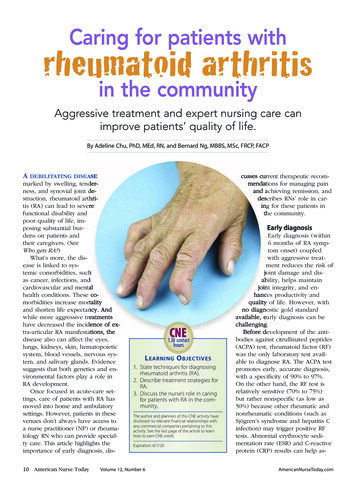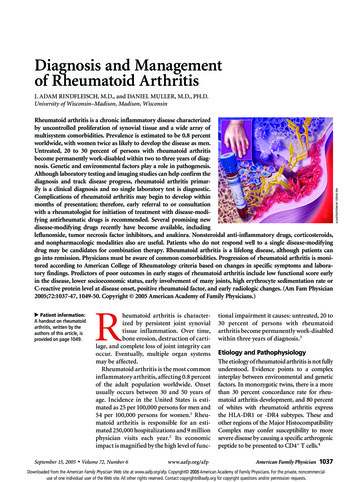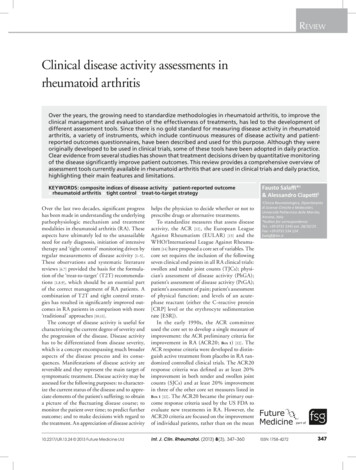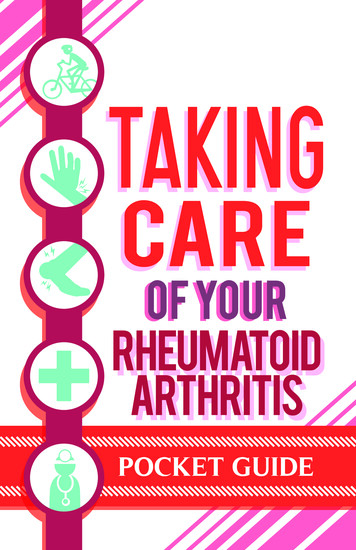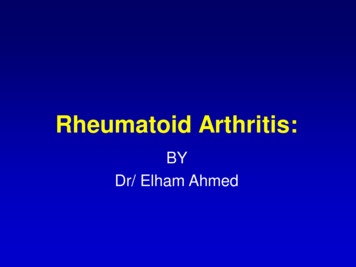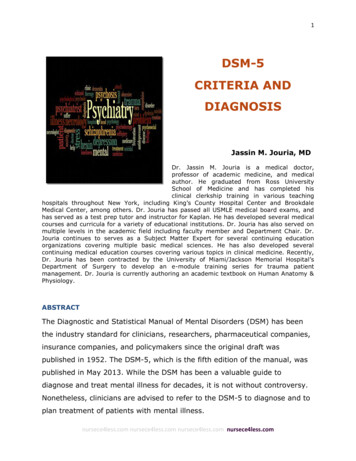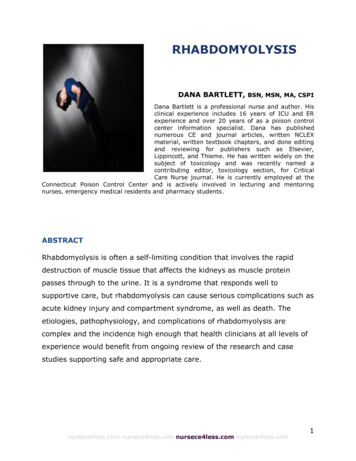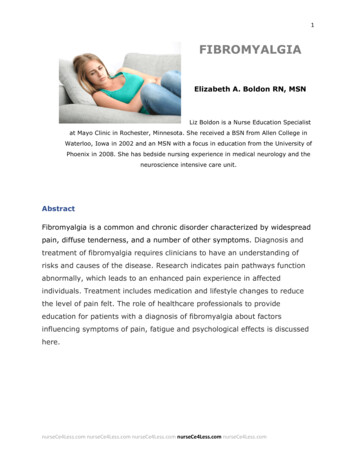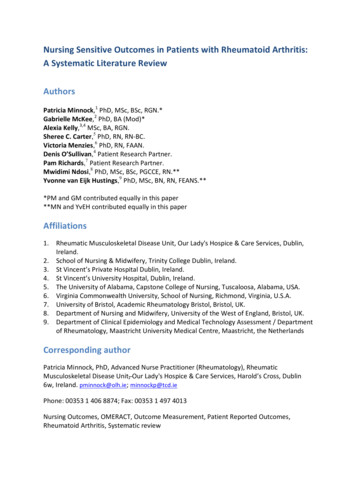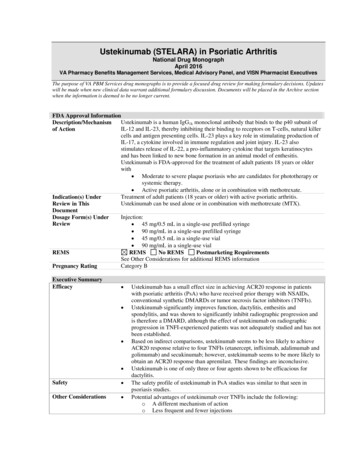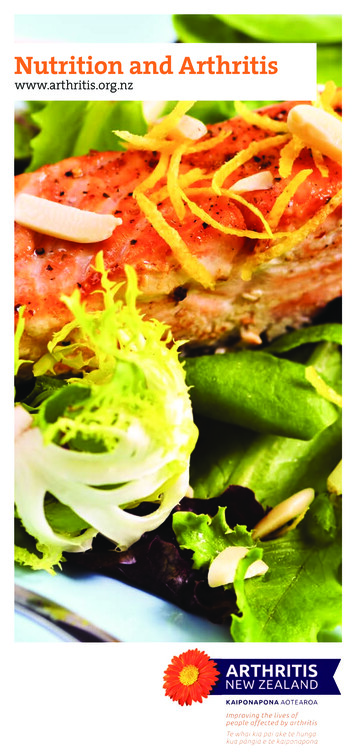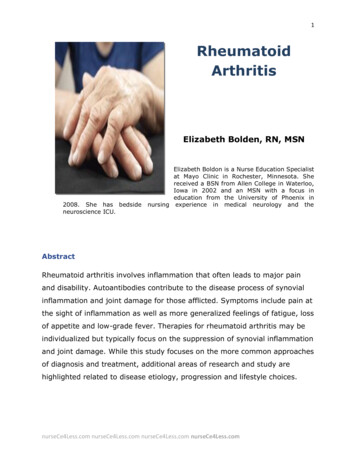
Transcription
1RheumatoidArthritisElizabeth Bolden, RN, MSN2008. She has bedsideneuroscience ICU.Elizabeth Boldon is a Nurse Education Specialistat Mayo Clinic in Rochester, Minnesota. Shereceived a BSN from Allen College in Waterloo,Iowa in 2002 and an MSN with a focus ineducation from the University of Phoenix innursing experience in medical neurology and theAbstractRheumatoid arthritis involves inflammation that often leads to major painand disability. Autoantibodies contribute to the disease process of synovialinflammation and joint damage for those afflicted. Symptoms include pain atthe sight of inflammation as well as more generalized feelings of fatigue, lossof appetite and low-grade fever. Therapies for rheumatoid arthritis may beindividualized but typically focus on the suppression of synovial inflammationand joint damage. While this study focuses on the more common approachesof diagnosis and treatment, additional areas of research and study arehighlighted related to disease etiology, progression and lifestyle choices.nurseCe4Less.com nurseCe4Less.com nurseCe4Less.com nurseCe4Less.com
2Continuing Nursing Education Course PlannersWilliam A. Cook, PhD, Director, Douglas Lawrence, MA, Webmaster,Susan DePasquale, MSN, FPMHNP-BC, Lead Nurse PlannerPolicy StatementThis activity has been planned and implemented in accordance with thepolicies of NurseCe4Less.com and the continuing nursing educationrequirements of the American Nurses Credentialing Center's Commission onAccreditation for registered nurses. It is the policy of NurseCe4Less.com toensure objectivity, transparency, and best practice in clinical education forall continuing nursing education (CNE) activities.Continuing Education Credit DesignationThis educational activity is credited for 1.5 hours. Nurses may only claimcredit commensurate with the credit awarded for completion of this courseactivity.Statement of Learning NeedNurses experienced in the evaluation of joint pain for patients affected byrheumatoid arthritis are better able to assess signs and symptoms and carryforward needed treatment. Since rheumatoid arthritis is a major cause ofdisability nation-wide, there is ongoing need for nursing education torecognize early signs of the disease and to provide ongoing treatment.nurseCe4Less.com nurseCe4Less.com nurseCe4Less.com nurseCe4Less.com
3Course PurposeTo enable nurses to increase their knowledge on caring for patients withRheumatoid Arthritis (RA).Target AudienceAdvanced Practice Registered Nurses and Registered Nurses(Interdisciplinary Health Team Members, including Vocational Nurses andMedical Assistants may obtain a Certificate of Completion)Course Author & Planning Team Conflict of Interest DisclosuresElizabeth Boldon, RN, MSN, William S. Cook, PhD, Douglas Lawrence, MA,Susan DePasquale, MSN, FPMHNP-BC – all have no disclosuresAcknowledgement of Commercial SupportThere is no commercial support for this course.Activity Review Information:Reviewed by Susan DePasquale, MSN, FPMHNP-BC.Release Date: 1/1/2016Termination Date: 7/16/2018Please take time to complete a self-assessment of knowledge, onpage 4, sample questions before reading the article.Opportunity to complete a self-assessment of knowledge learnedwill be provided at the end of the course.nurseCe4Less.com nurseCe4Less.com nurseCe4Less.com nurseCe4Less.com
41. Rheumatoid arthritis is an autoimmune diseasea. that is more common in men than women.b. commonly known as “wear and tear” arthritis.c. in which the body’s immune system mistakenly attacks the joints.d. which affects the cartilage but not the lining of the joints.2. True or False: There is no evidence that a specific climate canprevent or reduce the effects of rheumatoid arthritis.a. True.b. False.3. Rheumatoid factor (RF) is an antibody thata. is present in the blood of all patients with rheumatoid arthritis.b. if a person tests positive, he/she will develop rheumatoid arthritisc. is present in people with rheumatoid arthritis but no other disease.d. is present eventually in the blood of most people with rheumatoidarthritis.4. is a surgical procedure that involves removingthe joint and fusing the bones into one immobile unit.a. Synovectomyb. Arthrodesisc. PTPN22d. Microarray5. Osteoporosis is a conditiona. that may be avoided by patients who take corticosteroids.b. in which bones become weakened and fragile.c. that develops only in women who have pre-existing rheumatoidarthritis.d. caused by stress.nurseCe4Less.com nurseCe4Less.com nurseCe4Less.com nurseCe4Less.com
5IntroductionRheumatoid arthritis (RA) is a chronic inflammatory disorder that typicallyaffects the small joints in the hands and feet. Unlike the wear-and-teardamage of osteoarthritis, rheumatoid arthritis affects the lining of joints,causing a painful swelling that can eventually result in bone erosion and jointdeformity.An autoimmune disorder, rheumatoid arthritis occurs when the immunesystem mistakenly attacks the body's own tissues. In addition to causingjoint problems, rheumatoid arthritis sometimes can affect other organs ofthe body — such as the skin, eyes, lungs and blood vessels.1This course will discuss Rheumatoid arthritis as a disease process, includingthe symptoms, causes, risk factors, diagnosis and treatment as well as somecurrent research in the area of rheumatoid arthritis.What Is Rheumatoid Arthritis?Rheumatoid arthritis is an autoimmune disease in which the body’s immunesystem – which normally protects its health by attacking foreign substanceslike bacteria and viruses – mistakenly attacks the joints. This createsinflammation that causes the tissue that lines the inside of joints (thesynovium) to thicken, resulting in swelling and pain in and around the joints.The synovium makes a fluid that lubricates joints and helps them movesmoothly.2nurseCe4Less.com nurseCe4Less.com nurseCe4Less.com nurseCe4Less.com
6If inflammation goes unchecked, it can damage cartilage, the elastic tissuethat covers the ends of bones in a joint, as well as the bones themselves.Over time, there is loss of cartilage, and the joint spacing between bonescan become smaller. Joints can become loose, unstable, painful, and mobilityis reduced. Joint deformity also can occur. Joint damage cannot be reversed,and because it can occur early, doctors recommend early diagnosis andaggressive treatment to control RA.2Rheumatoid arthritis most commonly affects the joints of the hands, feet,wrists, elbows, knees and ankles. The joint effect is usually symmetrical,affecting both sides of the body. Because RA can also affect body systems,such as the cardiovascular or respiratory systems, it is referred to as asystemic illness and is sometimes called rheumatoid disease.2Symptoms of Rheumatoid ArthritisThe disease onset in RA is usually insidious, with the predominant symptomsbeing pain, stiffness (especially morning stiffness), and swelling of manyjoints. Typically, the joints of the fingers, the thumbs, the wrists, and thejoints of the toes are sites of arthritis early in the disease. Other synovialjoints of the upper and lower limbs, such as the elbows, shoulders, ankles,and knees, are also commonly affected.3Morning stiffness is a common feature of those with active RA; it can bedefined as "slowness or difficulty moving the joints when getting out of bedor after staying in one position too long, which involves both sides of thebody and gets better with movement."3 Morning stiffness lasting more thanone hour reflects a severity of joint inflammation that rarely occurs innurseCe4Less.com nurseCe4Less.com nurseCe4Less.com nurseCe4Less.com
7diseases other than RA, although morning stiffness, or stiffness after anyprolonged period of inactivity, is also seen in virtually all inflammatoryarthritis processes.3 Along with pain, many people experience fatigue, loss ofappetite and a low-grade fever.The symptoms and effects of rheumatoid arthritis may come and go. Aperiod of high disease activity (increases in inflammation and othersymptoms) is called a flare. A flare can last for days or months. Symptomsmay also subside or disappear for periods of time, called remissions. Overtime, rheumatoid arthritis can cause joints to deform and shift out of place.Ongoing high levels of inflammation can cause problems throughout thebody. Here are some ways rheumatoid arthritis can affect organs and bodysystems:2 Eyes:Dryness, pain, redness, sensitivity to light and impaired vision Mouth:Dryness and gum irritation or infection Skin:Rheumatoid nodules, which are small lumps under the skin over bonyareas Lungs:Inflammation and scarring that can lead to shortness of breath Blood Vessels:nurseCe4Less.com nurseCe4Less.com nurseCe4Less.com nurseCe4Less.com
8Inflammation of blood vessels that can lead to damage in the nerves,skin and other organs Blood:Anemia, a lower than normal number of red blood cells needed to carryadequate oxygen to body tissues, leading to feeling weakness andexhaustionCauses of Rheumatoid ArthritisThe cause of rheumatoid arthritis is not yet fully understood, althoughmedical providers do know that an abnormal response of the immunesystem plays a leading role in the inflammation and joint damage thatoccurs. No one knows for sure why the immune system goes awry, but thereis scientific evidence that genes, hormones and environmental factors areinvolved.2Research has shown that people with a specific genetic marker called theHLA shared epitope have a five-fold greater chance of developingrheumatoid arthritis than do people without the marker. The HLA genetic sitecontrols immune responses. Other genes connected to rheumatoid arthritisinclude STAT4, a gene that plays important roles in the regulation andactivation of the immune system; TRAF1 and C5, two genes relevant tochronic inflammation; and, PTPN22, a gene associated with both thedevelopment and progression of rheumatoid arthritis. Yet not all people withthese genes develop RA, and not all people with the condition have thesegenes.2nurseCe4Less.com nurseCe4Less.com nurseCe4Less.com nurseCe4Less.com
9Researchers continue to investigate other factors that may play a role. Thesefactors include infectious agents such as bacteria or viruses, which maytrigger development of the disease in a person whose genes make themmore susceptible to it; female hormones (seventy percent of people with RAare women); obesity; and, the body’s response to stressful events such asphysical or emotional trauma. Research also has indicated thatenvironmental factors may play a role in one's risk for rheumatoid arthritis.Some include exposure to cigarette smoke, air pollution, insecticides andoccupational exposures to mineral oil and silica.2Even though all the answers are not known, one thing is certain: rheumatoidarthritis develops as a result of an interaction of many factors. Researchersare trying to understand these factors and how they work together.Risk Factors for Rheumatoid ArthritisFactors that may increase the risk of rheumatoid arthritis include:1 Sex:Women are more likely to develop rheumatoid arthritis. Age:Rheumatoid arthritis can occur at any age, but it most commonly beginsbetween the ages of 40 and 60. Family history:If a member of a person’s family has rheumatoid arthritis, they may havean increased risk of the disease.nurseCe4Less.com nurseCe4Less.com nurseCe4Less.com nurseCe4Less.com
10Diagnosis Of Rheumatoid ArthritisRheumatoid arthritis can be difficult to diagnose in its early stages forseveral reasons. First, there is no single test for the disease. In addition,symptoms differ from person to person and can be more severe in somepeople than in others. Also, symptoms can be similar to those of other typesof arthritis and joint conditions, and it may take some time for otherconditions to be ruled out.Finally, the full range of symptoms develops over time, and only a fewsymptoms may be present in the early stages. As a result, medical providersuse a variety of the following tools to diagnose the disease and to rule outother conditions:4Medical HistoryThe medical provider begins by asking the patient to describe the symptoms,and when and how the condition started, as well as how the symptoms havechanged over time. The provider will also ask about any other medicalproblems the patient and close family members have and about anymedications the patient is taking. Accurate answers to these questions canhelp the provider make a diagnosis and understand the impact the diseasehas on the patient’s life.Good communication between patient and their medical provider isespecially important. For example, the patient’s description of pain, stiffness,and joint function and how these change over time is critical to theprovider’s initial assessment of the disease and how it changes over time.nurseCe4Less.com nurseCe4Less.com nurseCe4Less.com nurseCe4Less.com
11Physical ExaminationThe health provider will check the patient’s reflexes and general health,including muscle strength. The medical provider will also examinebothersome joints and observe the patient’s ability to walk, bend, and carryout activities of daily living. In addition, the skin is examined for a rash andthe provider will listen to the chest for signs of inflammation in the lungs.Laboratory TestsA number of lab tests may be useful in confirming a diagnosis of rheumatoidarthritis. Following are some of the more common ones:3 Rheumatoid factor (RF):Rheumatoid factor is an antibody that is present eventually in theblood of most people with rheumatoid arthritis. (An antibody is aspecial protein made by the immune system that normally helps fightforeign substances in the body.) Not all people with rheumatoidarthritis test positive for rheumatoid factor, and some people testpositive for rheumatoid factor, yet never develop the disease.Rheumatoid factor also can be positive in some other diseases;however, a positive RF in a person who has symptoms consistent withthose of rheumatoid ar
Rheumatoid arthritis (RA) is a chronic inflammatory disorder that typically affects the small joints in the hands and feet. Unlike the wear-and-tear damage of osteoarthritis, rheumatoid arthritis affects the lining of joints, causing a painful swelling that can eventually result in bone erosion and joint deformity.
